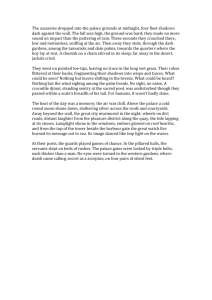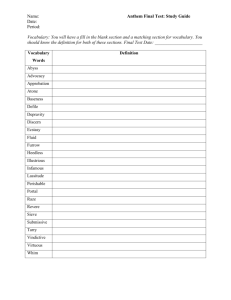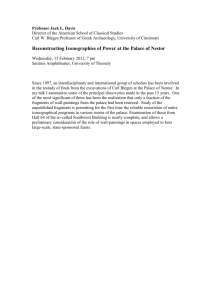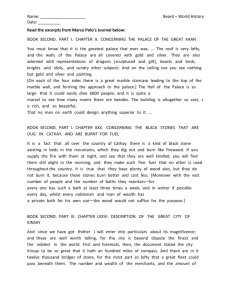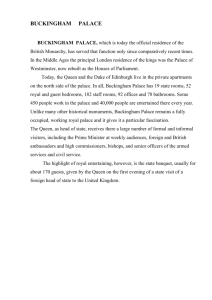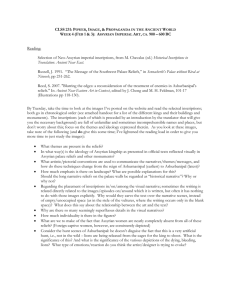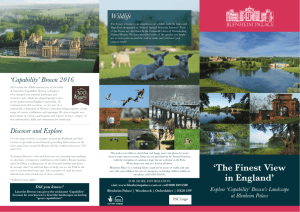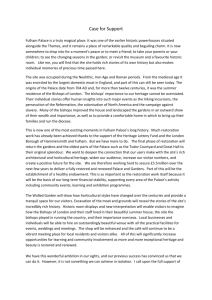Nineveh
advertisement
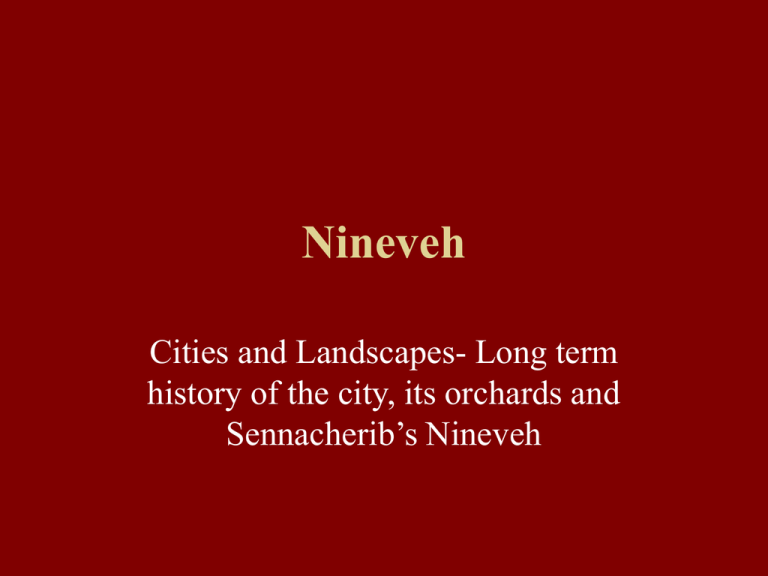
Nineveh Cities and Landscapes- Long term history of the city, its orchards and Sennacherib’s Nineveh Assyrian capitol as central place Funneling of resources to Central place “complex hierarchy of farmsteads, hamlets, villages, regional, and provincial centres…capital city at the pinnacle” (Barbares) High places and fortifications only at administration points—Tell Beydar survey Transformation of the population geography – Movement of political power base of empire to northern cities (Kalhu, Khorsabad, Nineveh) • Optimal region for combination of rainfall, irrigation, natural resources and defenses – Assyrian conquest and resettlement repopulating countryside and new cities • Cities densely populated with people from conquered regions. • Unfortified small settlements in low places— undefendable, at mercy of government – Possibly very intentional--Letter from official to Sargon II: ”the people living on the mounds should come down and build at the bottom; should the ten fortified towns in the desert come down as well?” (Barbares) Disarmament and defortification of noncentral loci—concentration of power. Shift to the North • Landscape of Northern Mesopotamia: – “gently rolling plains, pasturelands, and rugged hills, watered by perrenial rivers and spring rains… able to support large populations… (Barbares) Layout of Nineveh • Nineveh was huge! • 750 Hectares (1875 acres) • Absorbed by the modern Iraqi city of Mosul Promontories • Kouyunjik – Main Citadel • Nebi-Yunus – Secondary, military citadel “armory” or “arsenal” • Eastern Terrace – Perspectival vantage point – Gardens? Eastern Terrace – Nineveh had a new kind of urban space found in no other Mesopotamian city: the Eastern Terrace. • “The inclusion of the high eastern terrace within the walls, a feature unknown at Nimrud and Khorsabad, introduced an unprecedented third urban space, and viewpoint. The eastern terrace offered a new urban view which was different from the high view of the citadel or temple platform, and from the more common, low horizontal or upward-looking view of most urban dwellers at monuments and raised platforms.” –(Lumsden’s Production of Space at Nineveh) • Eastern Terrace provided sweeping views of city and was open to the public, unlike Kouyunjik citadel (palace/administrative functions) • Use of Eastern Terrace unclear: possibly day-today movement of people, marketplace, ceremonial? • Possibly watered by high level aqueduct as part of Sennacherib’s gardens and orchards EASTERN TERRACE • This new, different perspective of city led to new perspectives in artwork. Both offered residents of Nineveh a new way to experience their city: a panoramic, more cohesive and understandable view. • For centuries, reliefs were portrayed from lower viewpoint, action was all on ground-level. – 2 horizontal registers, raised band of inscription dividing them. – All figures stuck to this “ground line” and depth shown by overlapping figures, often of all different sizes. • In Sennacherib’s new style, action and figures were shown within a landscape, viewed from a bird’s eye view. – Distant figures are higher up and off the “ground line” – More complex landscapes & more figures, all seen from above, NOT eyelevel. – Central inscription band is gone; minimal overlapping • All these elements combined to make a more naturalistic style attempting to portray depth more than predecessors. • May have made little sense at first to people (used to older style reliefs); but with the eastern terrace it made sense (put into context). – Sennacherib’s Reliefs: limestone slabs with reliefs lined 70 rooms of the palace. • Scenes show quarrying, transporting, and carving of stone into massive colossi human-headed bulls, along w/ military themes (shown here: siege of Lachish). • Represented from a more “bird’s eye view” than all previous reliefs; showed more perspective than ever before • More naturalistic style shows in other artwork, as well: a 5th leg removed from bull statues guarding major doorways of palace • Biggest were 20 ft. tall & 4050 tons • The quarrying of the stone for them, along w/ transport & carving, was subject of reliefs in E & N walls of inner throne-room court of Sennacherib’s Royal Palace, located on the main citadel, the Kouyunjik. Kouyunjik • • • • Royal citadel at Nineveh About 40 hectares in area Palaces at periphery of citadel with temples at center Temple and Ziggurat to Ishtar centrally located, rebuilt by Assurnasipal II and Sargon II • Sennacherib’s palace on the southwest corner of the mound Sennacherib’s “Palace Without rival at Nineveh” • Built between 701 B.C.E. and 690 B.C.E. • 242 meters wide Documentation of Palace Construction • Intimate connection between the funneling of resources to the capital from military campaigns and the growth of the palace • Foundation cylinders describe military campaigns interleaved with building accounts –4 cylinders from Rassam’s excavations dated to 700 B.C. contain annals of Sennacherib’s first three military campaigns and a palace building account: “a palace of ivory, maple, boxwood, mulberry, cedar, cypress, and spruce, the ‘Palace without a Rival,’ for my royal abode”—Presumably a text from around the foundation of the palace, borrowing from his father Sargon • “Taylor Prism” inscribed in 690 or 691 has all eight military annals and account of the completion of the palace (Height:38.5cm) • Around 694 B.C.E., mixed annalistic, summary and building accounts were inscribed on the palace’s gateway colossi, with five military campaigns and a palace length of 700 cubits in 694 updated to six military campaigns and a palace length of 914 cubits in the following year. Bull Colossi Bull Colossi • Large numbers produced for city gates, palace, and armory • Sennacherib’s largest were about 20 ft square and forty or fifty tons • Commemorated in palace inscriptions, and in extensive reliefs showing the quarrying and transport of the stone for their construction Quarrying and iron tools Moving colossi Stone and Quarries • Unlike Lower Mesopotamia, there is an abundance of stone in Upper Mesopotamia, thus, the landscape supported extensive stone construction • Tastiate “across the Tigris” for white limestone, used in colossi construction; floating colossi across the Tigris only possible during spring floods: Sennacherib accounts in detail as his predecessors source for this stone • Limestone quarry known near Bavian, at the head of Aqueduct Sennacherib completed in 691. • Bavian quarry may be the new quarry on the east bank of the Tigris that Sennacherib opened, “near Nineveh, in the district of Balatai”, replacing Tastiate as source of white limestone for colossi construction: assumed to be about 35 Kilometers upriver of modern Mosul Bavian (Balatai) Quarry • May be the quarry on the east bank of the Tigris that Sennacherib opened, “near Nineveh, in the district of Balatai”, replacing Tastiate as source of white limestone for colossi construction: assumed to be about 35 Kilometers upriver of modern Mosul Distant Quarries • Stone from Mt. Nipur, (Judi Dagh) near modern Cizre, Turkey—Sennacherib’s fifth campaign (697 B.C.E.) with a surface like grains of “mottled barley” • Stone from Kapridargila, “on the border of Til-Barsip”, to the west, possibly “close-grained magnesian limestone” in room LIII • Gishnugallu stone from Mt. Ammanana, possibly AntiLebanon range NW of Damascus. Presumably precious highquality alabaster traditionally used for inlaying weapons, but found in sufficient quantities by Sennacherib to construct colossi with. Judi Dagh quarry relief Water • “citadel unit always located laterally along the city wall overlooking the river” (Barbanes) • Possible high level aqueduct to Eastern Terrace Many Gardens and Orchards • • • • • • • • Agricultural Horticultural King’s Pleasure gardens Botanical Zoological Medical Sacred Watered by aqueducts “Above the city and below the city I laid out parks. The wealth of the mountain and all lands, all the herbs of the land of Hatti, myrrh plants, among which fruitfulness was greater than their natural habitat, all kinds of mountain-vines, all fruits of all lands, herbs and fruit bearing trees I set out for my subjects” -Sennacherib “Hanging Gardens of Babylon” • Actually located at Nineveh • One of the “7 Wonders” of the ancient world Hanging Gardens? • Probably situated between Sennacherib’s palace and the Khosr River • Or as the “Eastern Terrace” King’s Pleasure Gardens • The King and his wife dine in the garden Ambassu--Botanical and zoological gardens • North of the Adad gate, NE of the city • Plants and animals from all regions of the empire • Hunting areas Conceptual Elements of Garden • • • • Fertility King as gardener and hunter Taming and recreating the natural world Vertical situation of palace, flanked by lush gardens • The charismatic character of the King, chosen by the gods to tame the world Halzi Gate • 70m protruding east façade single point of entry at the center, built at a slight angle to connect to bridge over adjacent moat • 22 orthostats with inscriptions referring to construction of Nineveh • 2 intact courtyard foundation boxes contained clay figurines—one of a lahmu and one of a lion-headed man, protective in intent. • 8 towers of varying quality construction presumably from hurried repairs in gate for protection (unsuccessfully) after initial military attacks (probably around 614B.C.) • gates narrowed to 2m keep out troops; heavy blocking stone placed in entrance • Halzi Gate: southernmost entry point to fortified eastern wall; attacked simultaneously with Adad Gate in extreme north in the summer of 612 B.C. • Over 12 skeletons of fallen soldiers at gate, left how they died • Arrowhead in leg, spearhead and dagger in skeleton • Probably some looting, but valuable objects were still with them: string of carnelian and lapis lazuli, other jewelry • This drew soldiers to opposite ends of city wall, then attacked middle area where river meets city – Sennacherib’s extensive waterworks system used for gardens and orchards was used against him. • Huge flooding: contemporary and biblical accounts say the palace was “dissolved” • City fell to coalition of Medes and Babylonians in summer 612 B.C. after a three month siege • “Sennacherib’s palace was pillaged and burned; the upper story collapsed into the lower and the ‘Palace Without Rival’ lay buried and forgotten for nearly two and a half millennia.” (Russell’s Bulls for the Palace and Order in the Empire).
